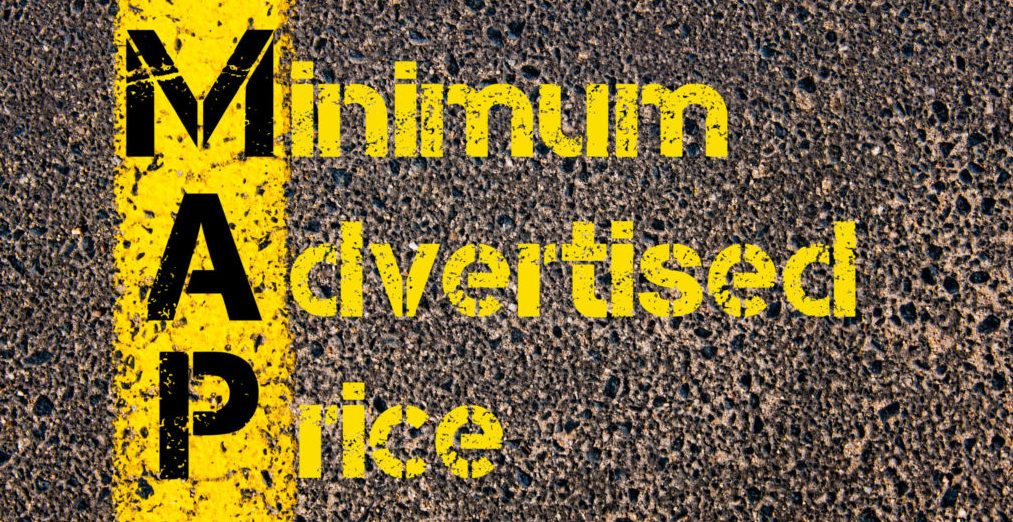
MAP, or Minimum Advertised Price, is a policy that a manufacturer or brand owner drafts and publishes to let the company’s resellers know the minimum prices they are willing to allow those resellers to advertise their products. The keyword in that last sentence is advertise.
A MAP pricing policy does not attempt to control or even suggest the prices that a manufacturer’s resale partners can actually sell its products. Those decisions will be between the retailers and their customers. The policy is designed to convey only the manufacturer’s expectations about how retailers advertise its products (often referred to in the legal profession as an “offer”).
And that brings us to one of the most commonly misunderstood aspects of a MAP pricing policy: What exactly is an advertised price?
What Does “Advertised” Mean in a MAP Policy?
A lot of the confusion about how to draft and enforce MAP pricing policies stems from a misunderstanding about what actually constitutes an advertised price (and what doesn’t).
In the offline world of bricks-and-mortar stores, federal law has been fairly consistent in interpreting an advertised price as any reference to a product’s price made available in any format outside the seller’s front door.
In other words, when your retail partners promote your products’ prices in newspaper ads, in radio commercials, on television, in online ads, on a roadside billboard, those will constitute advertising. This means if you enforce a MAP policy, your retail partners should adhere to your MAP pricing levels when they run any of those types of campaigns.
But inside their establishments, once a shopper has walked through a retailer’s front door, any reference to your prices in that store, no matter how public, will constitute resale price, not an offer or an advertised price. And here, inside the four walls of your retailers’ shops, your MAP pricing policy no longer applies.
That means if a retailer wants to hang a sign from its store’s ceiling advertising your products at a discount, the company won’t be in violation of your MAP pricing policy. The same is true if the retailer’s sales rep negotiates a lower price with a customer at the checkout counter, or if the store broadcasts a sale on your products over its public-address system.
The blurred line between “advertised” and “resale” price is why it’s trickier to enforce a MAP pricing policy online.

As you can imagine, this all becomes far less clear online , when a retailer’s “front door” could be open to interpretation. Is that door the retailer’s home page? The sales landing page of a particular product? Everything outside the shopping-cart page? And where is the front door of an Internet marketplace, like Amazon, where your resellers are almost certainly selling your products?
As you develop your company’s reseller pricing strategy, you will need to ask yourself several important questions. For example:
- Where will you want to draw the line in terms of what constitutes an “advertised” price (or an offer) on your retailer’s eCommerce page or the sales page they put up on an Internet marketplace like Amazon? Will it be just the price on the main page, for example, or will it include the in-cart pricing the customer sees only after adding the product to their shopping cart?
- Where, if anywhere, will you allow a retailer to post your products’ prices online below your MAP-approved levels without considering them in violation of your policy?
- Are there types of electronic customer communications you will be willing to let a retailer use to promote products below your MAP levels? For example, what if a retailer sends promotional text messages to its customers’ phones with short-term product discounts? If your company would consider these direct communications “offers” or “advertisements” (as opposed to actual selling prices), then you might want to extend your MAP strategy to include an eMAP pricing policy which covers all of a reseller’s electronic practices, including text messaging and other electronic communications with customers.
Although the line between advertised and resale pricing can get very blurry when it comes to your Internet retailers, there are steps you can take to protect your MAP prices and your brand when it comes to how your products are promoted online.
The Major Components of a MAP Pricing Policy

Later in this course, we will discuss in detail how to draft an effective, legal, and enforceable MAP pricing policy. For now, here is a brief overview of the major elements that should be included in any effective policy.
- A clear statement indicating this is a unilateral policy. Unilateral in this context has two meanings, both of which you will want to include in your policy’s language. First, it means your MAP pricing policy is a one-way statement of your company’s preferences for how retailers advertise your products, and not a two-way contract that a reseller is in effect agreeing to by selling those products. Second, unilateral means that your company established the guidelines written in this policy entirely on its own, and not in discussions or collaboration with any of your retailers, wholesalers, distributors, or even with other manufacturers or brands.
(In later lessons, we will discuss several reasons it is important to emphasize the unilateral nature of your MAP policy.) - A list of all products covered by the policy, along with the MAP-approved pricing for each product. You can also include here any exceptions to your MAP pricing, such as holidays or other timeframes during which you will allow retailers to advertise your products below their MAP-approved prices. Rather than adding all of their products’ MAP pricing details directly into the policy itself, many businesses today create a standalone page online for their MAP catalogs and include only a link to that page in the actual policy.
- A description of the consequences for violations. You might create several tiers of violations, such as cutting off inventory from a first-time offender only temporarily, but then removing a repeat violator permanently from your authorized dealer list.
- A Frequently Asked Questions section with answers to common inquiries you anticipate receiving from retailers, wholesalers, or even your own internal sales teams. Any form of communication about a MAP policy between the brand and one of its resale partners runs the risk of being interpreted as “collusion” by antitrust regulators. For this reason, a best practice is to minimize your employees’ communications with resale partners about your policy, and instead to develop standard answers to their common questions about it.
Okay, we’ve introduced you to a lot of information for our first module. Please take the following short quiz to see how much you’ve learned about the basics of a MAP policy.
